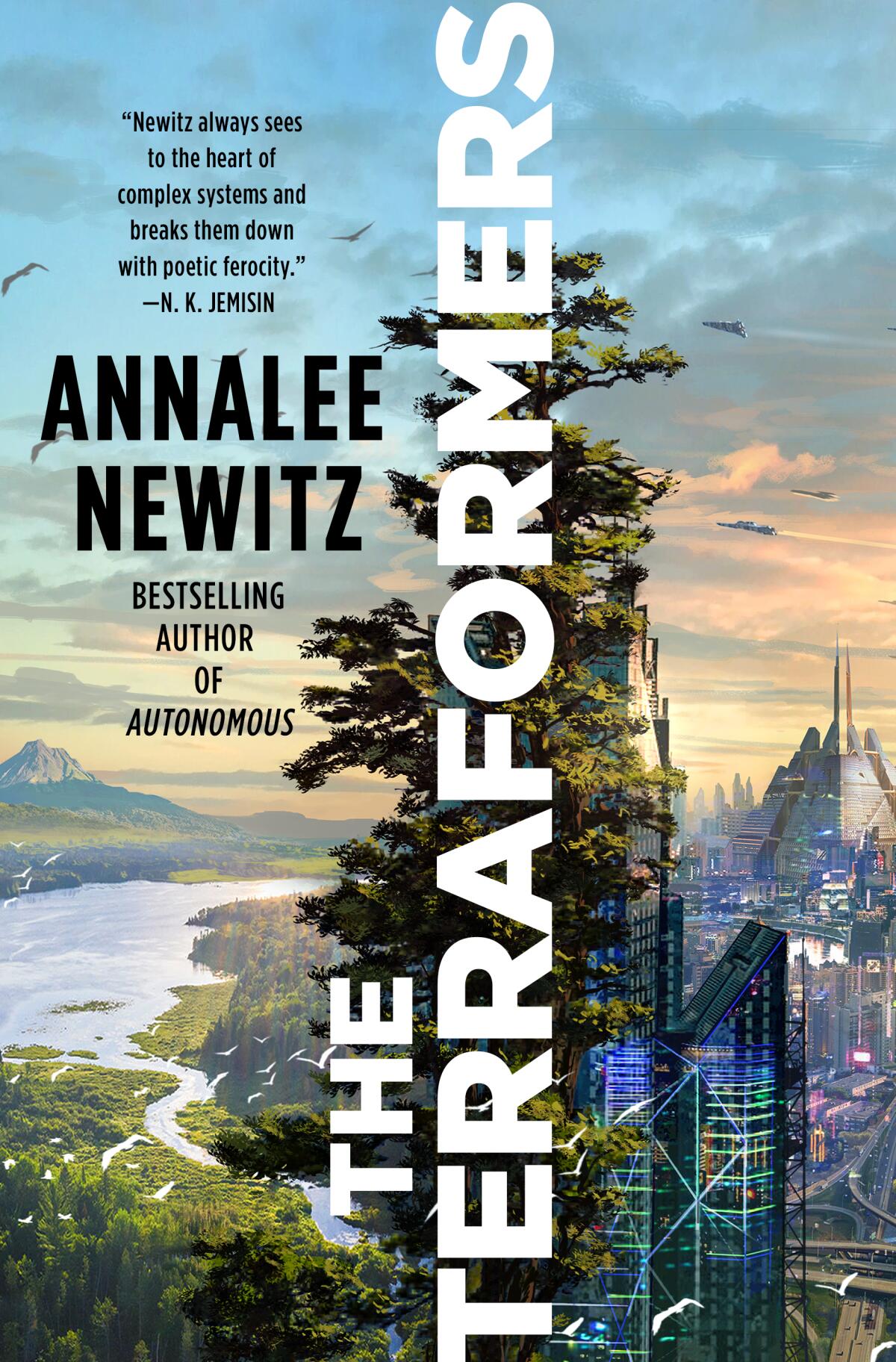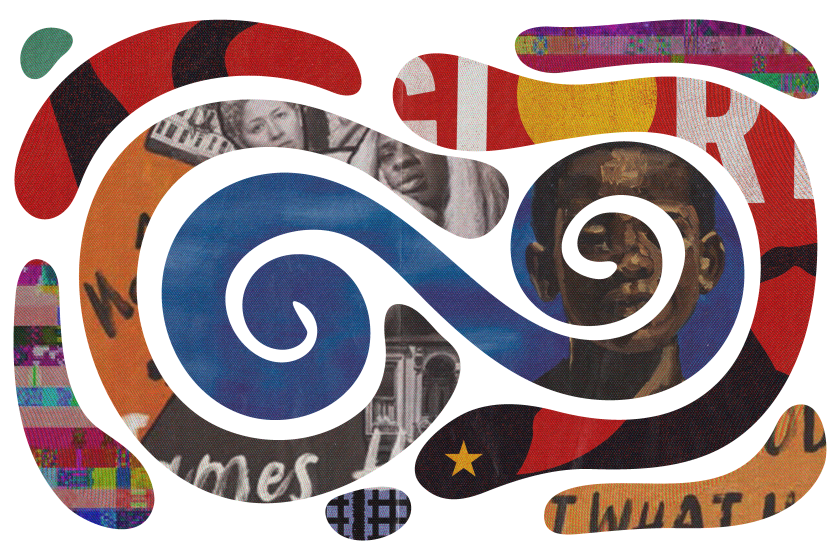In a new ‘galaxy brain’ novel, it’s AD 59,000 — and we’re still kind of a mess

- Share via
Review
The Terraformers
By Annalee Newitz
Tor: 352 pages, $29
If you buy books linked on our site, The Times may earn a commission from Bookshop.org, whose fees support independent bookstores.
In 2021, Annalee Newitz, a science journalist and science fiction novelist, published a remarkable book titled “Four Lost Cities.” Newitz visited the sites and studied the history of four ancient civilizations and found that “dead” isn’t quite the right word for what happens to once-mighty urban centers. Even Pompeii, famously buried by the eruption of Mt. Vesuvius in AD 79, wasn’t destroyed so much as reshuffled. “Cities” was an engrossing, offbeat book about urbanism, looking deep into the past with an eye on the present. “Maybe all our cities are in constant cycles of centralization and dispersal,” Newitz wrote. “Or if we think with our galaxy brains, they are temporary stops on the long road of human public history.”
“The Terraformers,” Newitz’s new novel, is an ingenious, galaxy-brain book. Set in the very distant future — circa AD 59,000 — it imagines human civilization evolving to the point where we can build new worlds and effectively process new types of creatures to steward them. Destry, a ranger monitoring a planet in progress in the novel’s early going, is a “hominin,” a human-like being who can live hundreds of years, and her fellow hominins peacefully cohabitate with different species. (Her steed is a flying, talking moose-like creature; naked mole rats abound.)
But the management of Destry’s planet, Sask-E, is handled by a distant corporation, Verdance, and corporations haven’t evolved much at all. “The Terraformers” is thick with space travel, whiz-bang technology and radical re-envisioning of intra-species relationships, but Newitz’s concerns are earth-bound. What bad compromises are made between populations and top-down leadership? How do tribalism and caste systems undermine societies? What makes any society sustainable? And (there’s a lot of this) why can’t we have better public transit?
It’s been a broken, chaotic year in life and in fiction. Authors such as Hernan Diaz and Namwali Serpell broke their novels and heroes into pieces.
This is a much broader canvas than Newitz has worked with before; their two previous novels concerned pharmaceuticals and robots (2017’s “Autonomous”) and time travel, gender and power (2019’s “The Future of Another Timeline”). Here, Newitz is a thorough and meticulous world-builder, almost to a fault — the narrative often delves deep into Sask-E’s weeds. But the heart of the story is a straightforward culture clash layered atop a capitalist critique.

Destry and her fellow rangers are charged with preparing the planet for future residents and for Verdance, which promises a bespoke extraterrestrial experience: “Settle on virgin Pleistocene land, with your pure H. sapiens neighbors, reliving the glory days of Earth.” Just as gentrification bigfoots ethnic enclaves in any major city, Verdance’s strategy threatens a whole other group: Destry and her crew discover a tribe near a volcano that was supposed to build the planet’s infrastructure and die off. Instead, they found a way to survive underground. Squabbles over who has the right to live — and where — escalate into outright battles, as the hominins strive to find a detente with the ancient community.
Eventually a treaty is struck. One character muses that it “could be a model for how to keep the balance in the future.” Thirty-odd millennia into the future, those are still famous last words.
Newitz has written an entertaining study of contentious social forces, concerned with how the lower rungs of any society are (mis)treated; ”The Terraformers” owes as much to E.P. Thompson as Isaac Asimov. On a smaller scale, Newitz calls out the casual bigotry that dismisses the intellect of groups disfavored by those in power — a point made here via the “intelligence assessment” ratings Verdance uses, mockingly dubbed “InAss.”
Chi Tai-we’s ‘The Membranes,’ finally out in English, is dated as sci-fi, but its mind-bending narrative was a prescient exploration of identity.
As an alternative, Newitz wants to celebrate the fluidity of relationships a more egalitarian society can offer. There are playful treks to Sask-E’s bawdier outposts and plenty of hybrid-species canoodling to boot. “The Terraformers” may be the best novel you’ll read this year about a tragic romance between two moose-like creatures.
But Newitz is generally more comfortable operating at the macro level — plate tectonics, river flow and transit all play central roles in the book’s plot, and each is handled with intelligence and often a delightful weirdness. In “Four Lost Cities,” Newitz argued that the main threats to civilizations are aggressive top-down leadership and a failure to protect the environment. The same dynamic plays out here, as Verdance’s stubborn efforts to build a standard-issue train line ignore the ways communities evolve.
Newitz’s solution in “The Terraformers” — a flying worm-like train that can evolve with residents’ needs — is a tick impractical. We’ll need a few millennia to catch up to it. But the impossibility of the real-world fix doesn’t diminish a message that can be applied now: Treat communities equally, recognize their shifting natures and ensure that they’re not abused in the name of some outsider’s notion of “authenticity.”
These points can get clotted in the book’s late going, as Verdance leadership becomes increasingly one-note and authoritarian; even the inevitable battle scenes can feel passionless in comparison with Newitz’s true passion, urbanist rhetoric. And because the book’s three-part structure introduces a new set of characters each time, it’s harder to feel invested in any one of them, even as their homes are blasted into oblivion.
Annalee Newitz’s second novel, ‘The Future of Another Timeline,’ pulses with a dystopian heart.
In some ways, Newitz has done the job too well. “The Terraformers” is so good at imagining how people undermine their own societies that it seems downright miraculous imagining we’ll make it to the year 3000, let alone 30,000. But Newitz’s optimism is well-argued and enchanting.
“Four Lost Cities” listed a few of the elements of a healthy city: “good reservoirs and roads, accessible public plazas, domestic spaces for everyone, social mobility, and leaders who treat the city’s workers with dignity.” We don’t need to build new creatures or find new worlds to create that, but even if we do, the same challenges will remain. The solutions will require the kind of leaps of imagination Newitz is confident we possess. Our galaxy brains have a lot of work to do.
Athitakis is a writer in Phoenix and author of “The New Midwest.”
More to Read
Sign up for our Book Club newsletter
Get the latest news, events and more from the Los Angeles Times Book Club, and help us get L.A. reading and talking.
You may occasionally receive promotional content from the Los Angeles Times.







